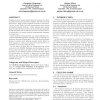Free Online Productivity Tools
i2Speak
i2Symbol
i2OCR
iTex2Img
iWeb2Print
iWeb2Shot
i2Type
iPdf2Split
iPdf2Merge
i2Bopomofo
i2Arabic
i2Style
i2Image
i2PDF
iLatex2Rtf
Sci2ools
SIGADA
2004
Springer
2004
Springer
Enforcing security and safety models with an information flow analysis tool
Existing security models require that information of a given security level be prevented from “leaking” into lower-security information. High-security applications must be demonstrably free of such leaks, but such demonstration may require substantial manual analysis. Other authors have argued that the natural way to enforce these models automatically is with information-flow analysis, but have not shown this to be practicable for general purpose programming languages in current use. Modern safety-critical systems can contain software components with differing safety integrity levels, potentially operating in the same address space. This case poses problems similar to systems with differing security levels; failure to show separation of data may require the entire system to be validated at the higher integrity level. In this paper we show how the information flow model enforced by the SPARK Examiner provides support for enforcing these security and safety models. We describe a...
| Added | 02 Jul 2010 |
| Updated | 02 Jul 2010 |
| Type | Conference |
| Year | 2004 |
| Where | SIGADA |
| Authors | Roderick Chapman, Adrian Hilton |
Comments (0)

